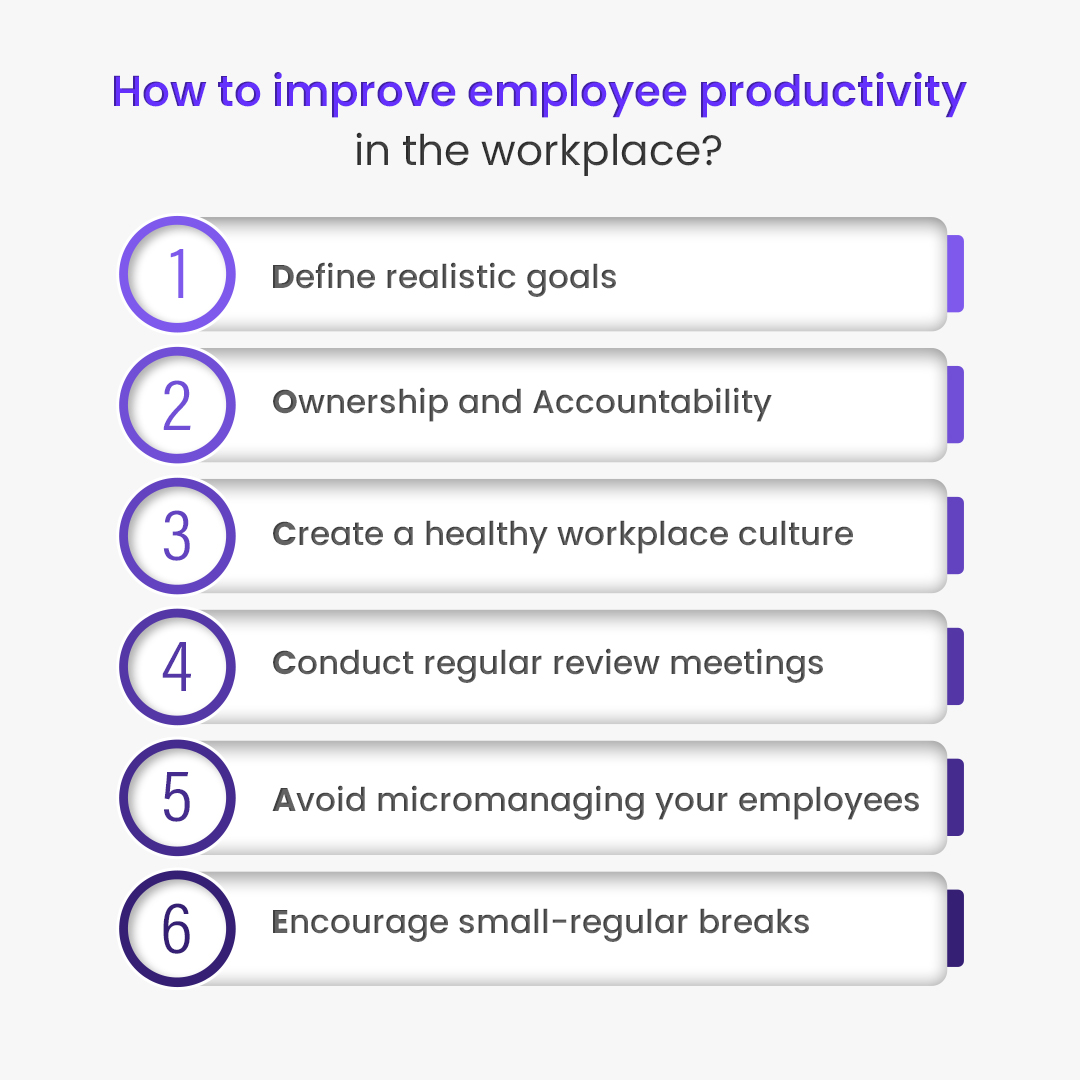
Most thriving businesses succeed because they understand the importance of employee efficiency and workplace productivity in the working environment.
Knowing how to make your employees efficient and productive is of great advantage. Workplace productivity is a vital key to improving revenue. It takes your team to the next level and grows your business exceptionally.
Organisational productivity is a result of employee engagement, managers’ expectations and the working environment. An employee is said to be productive when he/ she is engaged, has clear and realistic goals and delivers high-quality work on time.
Workplace Productivity 101: How to Improve Employee Productivity in the Workplace?
In the real world, many factors influence productivity. Here are my six personal favourite tips to increase productivity in the workplace:
1. Define Realistic Goals
Productivity is not defined by the number of hours employees engage with their laptops. It is more about their productive engagements and timely accomplishments of the tasks.
Step back and picture what productivity looks like to you and your team. Is it less time taken to complete projects? Is it better business revenue? Or is it more projects coming to your team?
You cannot track, measure and improve employee productivity until you are clear on what productivity means to you.

Thus, your first step in tracking productivity is to define what productivity means to you in measurable terms and create benchmarks. Then, the immediate action will be to ensure that everyone in the organisation, such as managers, and employees, are on the same page with these productivity benchmarks.
2. Ownership and Accountability
One of the best ways to increase workplace productivity is by holding employees accountable for the designated tasks.
Employees should feel a sense of ownership in the tasks allocated to them. This allows them to assume responsibility and go the extra mile in delivering projects in an acceptable manner.
3. Create a Healthy Workplace Culture
Employee productivity is directly linked to organisational culture. To improve workplace productivity, a highly engaged work environment is essential.
A positive working culture is one where employees are heard, respected, given freedom of creativity, allowed to take calculated risks, receive timely support from management, and are recognised for their efforts.
As a leader, understand the needs and concerns of your team to create a healthy workplace for all!
4. Conduct Regular Review Meetings
Tracking and measuring the productivity of individual teams is essential for improving productivity.
One of the best ways to track progress on tasks assigned to the employees is by conducting regular review meetings.
Employees could be stuck and unable to proceed. With these meetings, you gauge their understanding of the project and take updates on the status and progress being made.
The end goal of these meetings is to identify the challenges faced by employees and assist them in a timely manner. Constructive criticism of an employee should motivate them and improve their confidence level which will help them do better in the future.
5. Avoid Micromanaging Your Employees
Micromanagement hinders the growth of employees especially in an IT environment. Yes, employees need regular feedback and directions but that doesn’t mean you have to assist them in every small step taken.
Empower them with proper training, define their duties and responsibilities beforehand and give them the space to carry out tasks. This encourages employees to think independently and work productively.
6. Encourage Small-regular Breaks
Employees are not robots. When treated like one, they’ll feel burnout and lose the heart to work on projects.
Instead, be human and treat your team with humanity. Rather than working for prolonged hours, encourage your employees to take short breaks. They can stroll in the garden, grab a cup of tea or coffee. This will help them relax their mind and sustain better focus.
Thus, motivate your employees to take regular breaks and help them leverage increased energy and fresh minds to be more productive in the workplace.
The increase in productivity levels will be easily observed when you deploy these tips into your working environment.
Conclusion
Employee productivity is the top concern of management. As a manager, foster a culture of trust, respect and open communication in the workplace. Invest in the right resources to equip your employees with the skills and knowledge required to excel in their roles and responsibilities.
Lastly, employee productivity is directly linked with employee satisfaction. Ensure that they have a great time working in the organisation and timely reward them for all their efforts and achievements. Remember, employee productivity is challenging but equally rewarding!
Follow me on LinkedIn



